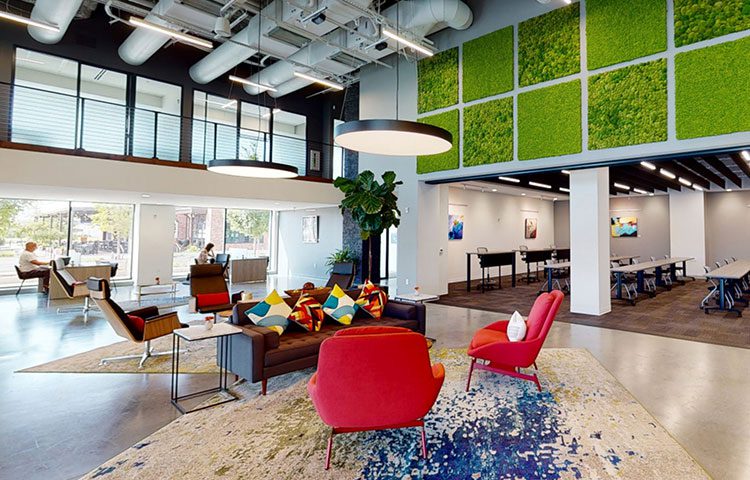Presented By: Serendipity Labs
Is Flexible Office Space Now A Must-Have Offering For Office Landlords?
Future Of Flex, presented by Serendipity Labs
By Serendipity Labs October 18, 2021 8:00 am
reprints
The world of the office has experienced dramatic changes in the past few years, and part of this is the increasing embrace of flexible office solutions. Once an afterthought in the office industry, flex space has quickly evolved into a must-have offering for landlords seeking to build, or even preserve, asset value.
Partner Insights spoke to John Arenas, CEO of Serendipity Labs, about the changing role of flex space in the national office landscape.
Commercial Observer: What does Serendipity Labs do?
John Arenas: Serendipity Labs is an international flexible office brand and operator with 30 locations in the U.S. and the U.K., mostly in suburban markets. We license and operate our brand on behalf of asset owners under management agreements, as opposed to becoming a tenant of the landlord. Serendipity Labs is a real estate service provider allowing clients to unlock value on their assets by meeting the new demand for flexible workplace.
CO: Who are some of the prominent companies Serendipity Labs has served and partnered with?
JA: On the occupier side, if I started at the top of the alphabet, I could say ADP, Amazon, Anthem Health and keep going from there. Companies like these use us as a strategic solution, as opposed to just renting out a number of desks for a set period of time. We’re helping them extend their fixed workplace with a strategy — to address growth, for example, or enter a new market. On the asset side, Serendipity Labs is a preferred provider for real estate service firms like JLL, CBRE, Cushman & Wakefield and others, where we offer our inventory, pricing and availability into their systems so that they can be sales channels for us.
CO: How have recent changes in the nature of work contributed to office landlords developing additional flex space offerings?
JA: Everybody learned to work remotely during the pandemic. Now, getting back to the office means evolving toward a hybrid approach. So flexible office suppliers and the landlords that partner with them are really serving this new demand for more flexible arrangements and shorter leases, which we think is a permanent shift. But it’s very hard for a landlord to do a short-term lease. On traditional long-term leases, they’re really not making money until year three or four. Having a pre-built or flexible product in the building solves this. Landlords realize they’re all in the flexible office business now, and it’s coming from tenant demand.
CO: When an office landlord decides to make flex part of their offerings, how does Serendipity Labs help them do that?
JA: We start by helping them conduct due diligence, market analysis, capital budgeting and detailed financial modeling. This serves as an investment case for landlords to take to their investment committee. Serendipity Labs is really working as a consultant in the beginning to help them decide how much flex they should have, and how it should be developed and run. We also have an advantage because of our global supply chain. We manufacture furniture, wall systems, flooring, lighting and more, and it dramatically reduces the cost of construction for new flex space. We also employ the power of our brand — our central marketing, and our central sales and strategic channel partnerships. This allows Serendipity Labs to generate revenue at the location level from central marketing resources, meaning that 80 percent of all revenue we deliver into a location comes from sources other than local marketing.
CO: How will offering flex office space help landlords maximize the value of their asset?
JA: According to JLL, the demand for flexible office space will become 30 percent of the entire market between now and 2030, and that prediction was made before the pandemic. So, the real question is, what happens to asset value if landlords don’t have a flex space offering? It’s hard to imagine the value of that asset being sustained. Offering flex office space helps them remain competitive. About 50 percent of lease transactions are for less than 5,000 square feet. That’s the sweet spot of coworking and flex office. If that’s half the market and your building doesn’t have flex, then clients looking for this are going to a building that does.
CO: How does Serendipity Labs help companies embrace the hub-and-spoke model that arose during the pandemic?
JA: The hub-and spoke-model, or core and flex, requires a network of suburban locations. Serendipity Labs is uniquely qualified to offer a hub-and-spoke solution because we’re the only coworking brand that has a true, national suburban network. For example, in the New York metro area, we have a city center location in lower Manhattan, and we’re in suburban counties throughout Connecticut, Westchester and New Jersey.
CO: How does your significant national presence benefit your clients on both the landlord and occupier sides?
JA: Having a national presence means that we have a network effect and brand power, and when we have a client in one location, that same client has the opportunity to expand with the same trusted solution across the country. When a company like Compass comes to us and says we want to roll out into a dozen markets across the United States, it’s a one-page agreement because of a master service agreement in place, and we can quickly create mobile drop-in plans so that all their employees can use all of our locations.
CO: How does the Serendipity Labs real estate service model provide stability for tenants and flexibility for landlords?
JA: That is an important distinction for Serendipity Labs — our real estate service model. It’s important because we have two big constituencies. One is the landlord, where we’re doing management, marketing and service delivery at the location. And for the occupier, we’re creating an experience that is well defined so they can use us from place to place and time to time, which affords them an extension of their fixed real estate. So providing an extension of the fixed corporate workplace to meet compliance standards and help companies attract, retain and now bring people back to the workplace is a really big difference when you have a national brand. We provide sales, marketing, financial planning, design, construction, procurement and innovation — all in the background, and the landlord is benefiting from it. That’s the symbiosis of being a real estate service firm. We help the landlords satisfy their investment goals, and occupiers fulfill their real estate strategies.
View more articles on Flex here


